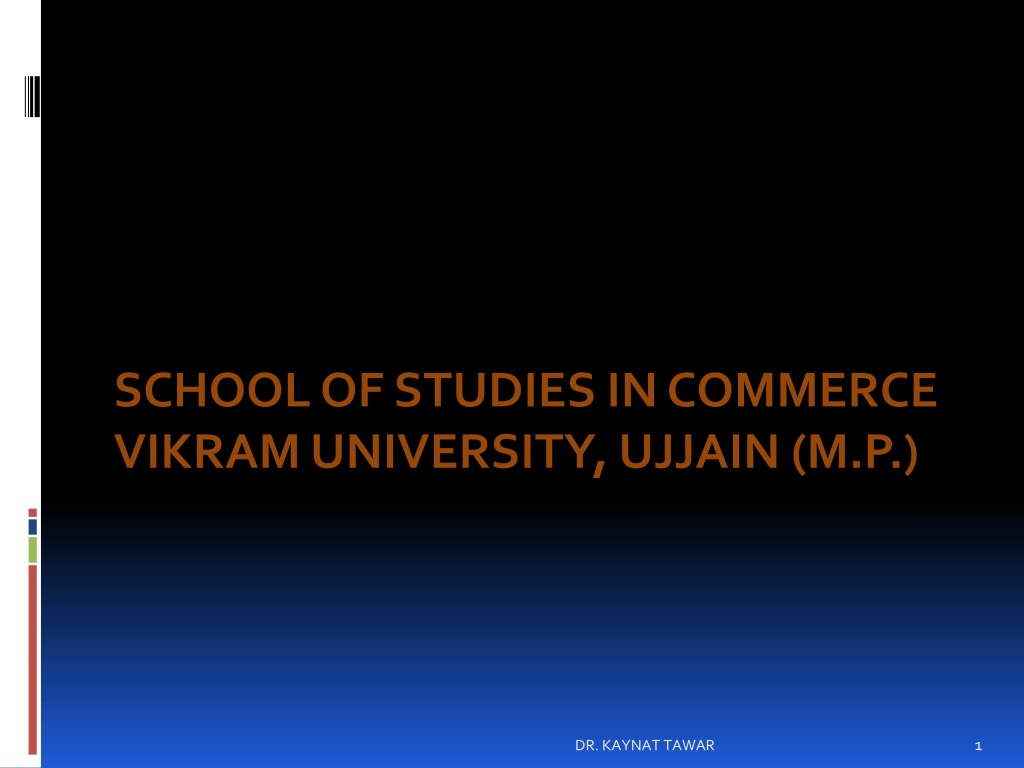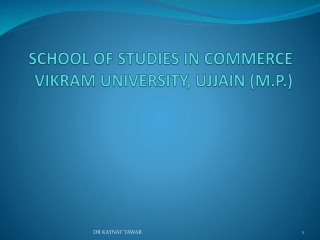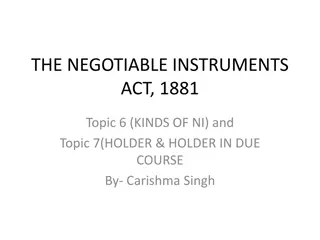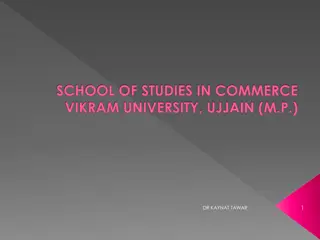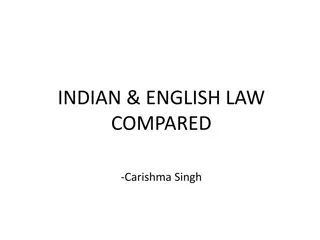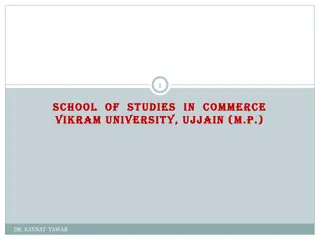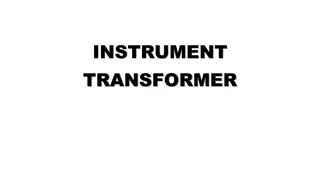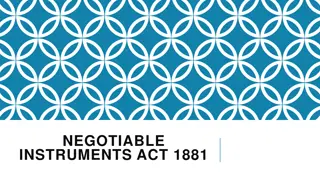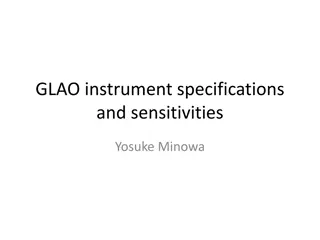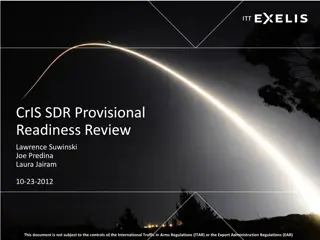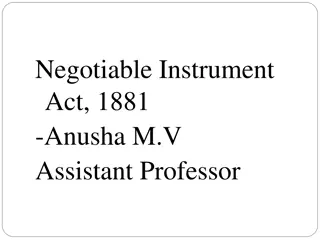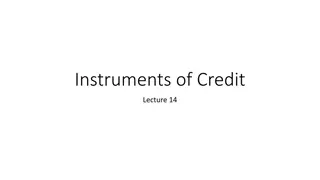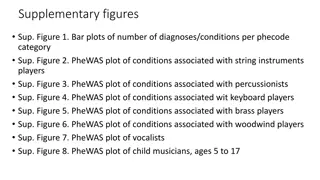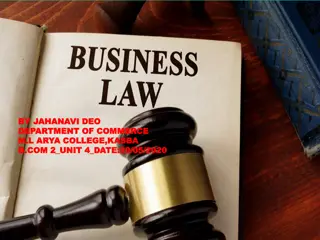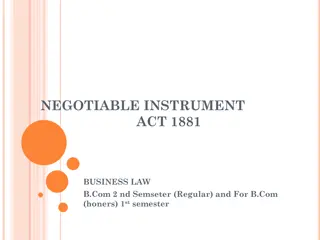Understanding the Negotiable Instrument Act of 1881 by Dr. Kaynat Tawar at Vikram University
Delve into the intricacies of the Negotiable Instrument Act of 1881 through lectures by Dr. Kaynat Tawar at Vikram University. Explore topics like parties involved, essentials, types of instruments, and the significance of negotiability. Gain insights on the history, application, and key provisions of this important act in India's commerce landscape.
Download Presentation

Please find below an Image/Link to download the presentation.
The content on the website is provided AS IS for your information and personal use only. It may not be sold, licensed, or shared on other websites without obtaining consent from the author. Download presentation by click this link. If you encounter any issues during the download, it is possible that the publisher has removed the file from their server.
E N D
Presentation Transcript
SCHOOL OF STUDIES IN COMMERCE VIKRAM UNIVERSITY, UJJAIN (M.P.) 1 DR. KAYNAT TAWAR
THE NEGOTIABLE INSTRUMENT ACT, 1881 LECTURE BY : DR. KAYNAT TAWAR 2 DR. KAYNAT TAWAR
RELEVANT TOPICS ON THE NEGOTIABLE INSTRUMENT ACT, 1881 FOR B.COM (HONS.) B.B.A. (HONS.) M.COM. 3 DR. KAYNAT TAWAR
TOPICS MEANING DEFINITION CHARACTERISTICS OF NEGOTIABLE INSTRUMENT FORMS OF NEGOTIABLE INSTRUMENT FEATURES OF A NEGOTIABLE INSTRUMENT TYPES OF NEGOTIABLE INSTRUMENT PROMISSORY NOTE SPECIMEN OF PROMISSORY NOTE PARTIES TO A PROMISSORY NOTE ESSENTIALS OF PROMISSORY NOTE BILL OF EXCHANGE SPECIAL BENEFITS OF BILL OF EXCHANGE MECHANICS OF A BILL FINANCING SPECIMEN OF BILL OF EXCHANGE 4 DR. KAYNAT TAWAR
PARTIES TO A BILL OF EXCHANGE ESSENTIALS OF A BILL OF EXCHANGE TYPES OF BILL OF EXCHANGE INLAND & FOREIGN BILL CLASSIFICATION OF BILL OF EXCHANGE DIFFERENCE BETWEEN BILL OF EXCHANGE AND PROMISSORY NOTE CHEQUE DEFINITION EESENTIAL ELEMENTS OF A CHEQUE PARTIES TO A CHEQUE SPECIMEN OF CHEQUE TYPES OF CROSSING 5 DR. KAYNAT TAWAR
CROSSING OF CHEQUES DIFFERENCE BETWEEN BILL OF EXCHANGE AND CHEQUE NEGOTIATION MODES OF NEGOTIATION ENDORSEMENT (SECTION 15) WHO MAY ENDORSE / NEGOTIATE (SECTION 5) ESSENTIAL OF A VALID ENDORSEMENT TYPES / KINDS OF ENDORSEMENT DISCHARGE OF NEGOTIABLE INSTRUMENT DISHONOUR OF NEGOTIABLE INSTRUMENT 6 DR. KAYNAT TAWAR
MEANING The negotiable instrument act was enacted, in India in 1881. prior to its enactment, the provision of the English negotiable act were applicable in India, and the present act is also based on the English act with certain modifications. It extends to the whole of India except the state of Jammu and Kashmir. The act operates subject to the provisions of section 31 and 32 of the reserve bank of India act,1934. 7 DR. KAYNAT TAWAR
WHAT IS NEGOTIABLE ? Negotiable means transferable. The negotiable that goes on refers to the transfer of the instrument between two people, or from one bank to another, or even from one country to another. WHAT IS AN INSTRUMENT ? In the broadest sense, almost any agreed-upon medium of exchange could be considered a negotiable instrument. In day to day banking, a negotiable instrument usually refers to checks, drafts, bill of exchange, and some types of promissory notes. 8 DR. KAYNAT TAWAR
DEFINITION A negotiable instrument means a promissory note, bill of exchange, or cheque payable either to order or to bearer. *ACCORDING TO SECTION 13 (1) OF THE NEGOTIABLE INSTRUMENT A negotiable instrument may be made payable to two or more payees jointly, or it may be made payable in the alternative to two or one or some of several payees. *ACCORDING TO SECTION 13 (2) OF THE NEGOTIABLE INSTRUMENT 9 DR. KAYNAT TAWAR
CHARACTERISTICS OF NEGOTIABLE INSTRUMENT 1. FREE TRANSFERABILITY OR EASY NEGOTIABILITY : Negotiable instrument is freely transferable from one person to another without any formality. The property (right of ownership) in these instruments passes by either endorsement and delivery (in case it is payable to order) or by delivery merely (in case it is payable to bearer) and no further evidence of transfer is needed. 2.TITLE OF HOLDERS IS FREE FROM ALL DEFECTS : A person who takes negotiable instrument bona fide and for value gets the instrument free from all defects in the title. The holder in due course is not affected by defective title of the transferor or of any other party. 10 DR. KAYNAT TAWAR
3. TRANSFEREE CAN SUE IN HIS OWN NAME WITHOUT GIVING NOTICE TO THE DEBTORS : A bill ,note or cheque represents a debt, i.e., an actionable claim and implies the right of the creditor to recover something from hid debtor. The creditor can either recover this amount himself or can transfer his right to another person. In case he transfers his right, the transferee of a negotiable instrument is entitled to sue on the instrument in his own name in case of dishonour, without giving notice to the debtors of the fact that he has become holder. In case of transfer or assignment of an ordinary actionable claim i.e. a book debt evidenced by an entry by the creditor in his account book, under the transfer of property act, notice to the debtor is necessary in order to make the transferee entitled to sue in his own name. 11 DR. KAYNAT TAWAR
4. PRESUMPTIONS : Certain presumptions apply to all negotiable instruments. Section 118 and 119 lay down the following presumption: (a) For consideration : That every negotiable instrument, was made, drawn, accepted, endorsed or transferred for consideration. (b) As to date : That every negotiable instrument bearing a date was made or drawn on such date. (c) As to time of acceptance : That every bill of exchange was accepted within a reasonable time after its date and before its maturity. (d) As to transfer : That every transfer of a negotiable instrument was made before its maturity. 12 DR. KAYNAT TAWAR
(e) As to time of endorsements : That the endorsements appearing upon a negotiable instrument were made in the order in which they appear thereon. (f) As to stamps : That a lost promissory- note, bill of exchange or cheque was duly stamped. (g) As to a holder in due course : That every holder of a negotiable instrument is holder in due course (this presumption would not arise where it is proved that the holder has obtained the instrument from its lawful owner, or from any person in lawful custody thereof, by means of an offence, fraud or for unlawful consideration and in such a case the holder has to prove that he is a holder in due course. (h) As to dishonor : That the instrument was dishonored, in case a suit upon a dishonored instrument is filed with the court and the fact of protest is proved. 13 DR. KAYNAT TAWAR
FORMS OF NEGOTIABLE INSTRUMENT A negotiable instrument is a written, order promising to pay sum of money. A document becomes negotiable when it contains an unconditional promise to pay money and is payable to a bearer or payable on demand. 14 DR. KAYNAT TAWAR
FEATURES OF A NEGOTIABLE INSTRUMENT It is written document by which certain rights are created and or / transferred to a certain person. It must be signed by the maker or the drawer as the case may be. There must exist the unconditional order or promise to pay. There must be a time mentioned for such payment. In particular cases, the drawee s name should be specifically mentioned. 15 DR. KAYNAT TAWAR
TYPES OF NEGOTIABLE INSTRUMENT 16 DR. KAYNAT TAWAR
Negotiable instrument are of two types which are as follow : Negotiable instruments recognized by status : e.g. bills of exchange, cheque and promissory notes. Negotiable instruments recognized by usage or customs of trade : e.g. bank notes, exchequer bills, share warrants, bearer debentures, dividend warrants, share certificate. 17 DR. KAYNAT TAWAR
PROMISSORY NOTE A promissory note is an instrument in writing (not being a bank note or a currency note) containing an unconditional undertaking, signed by the maker, to pay a certain sum of money to or to the order of a certain person, or to the bearer of the instruments. *ACCORDING TO SECTION 4 OF THE ACT ILLUSTRATION: A signs instruments in the following terms: (a) I promise to pay B or order Rs. 500. (b) I promise to pay B Rs. 500 which shall be due to him. (c) I promise to pay B Rs. 500 seven days after my marriage with C. 18 DR. KAYNAT TAWAR
SPECIMEN OF PROMISSORY NOTE 19 DR. KAYNAT TAWAR
SPECIMEN OF PROMISSORY NOTE 20 DR. KAYNAT TAWAR
PARTIES TO A PROMISSORY NOTE There are primarily two parties involved in a promissory note. They are : (I) THE MAKER OR DRAWER : the person who makes the note and promises to pay the amount stated therein. In the above specimen, Sanjeev is the maker or drawer. (II) THE PAYEE : the person to whom the amount is payable. In the above specimen it is Ramesh. * In course of transfer of a promissory note by payee and others, the parties involved may be (A) THE ENDORSER The person who endorses the note in favour of another person. In the above specimen if Ramesh endorses it in favour Ranjan and Ranjan also endorses it in favour of Puneet, then Ramesh and Ranjan both are endorsers. (B) THE ENDORSEE The person in whose favour the note is negotiated by endorsement. In the above, it is Ranjan and then Puneet. 21 DR. KAYNAT TAWAR
ESSENTIALS OF PROMISSORY NOTE 1. IT MUST BE IN WRITING : A promissory note has to be in writing. An oral promise to pay dose not become a promissory note. The writing may be on any paper or book. ILLUSTRATIONS: A signs the instruments in the following terms: I promise to pay B or order Rs. 500. I acknowledge myself to be indebted to B in Rs. 1000 to be paid on demand, for value received. Both the above instruments are valid promissory notes. 22 DR. KAYNAT TAWAR
2. IT MUST CONTAIN A PROMISE OR UNDERTAKING TO PAY : There must be a promise or an undertaking to pay. The undertaking to pay may be gathered either from express words or by necessary implication. A mere acknowledgement of indebtedness is not a promissory note, although it is valid as an agreement and may be sued upon as such. ILLUSTRATION : A signs the instruments in the following terms : Mr. B, I owe you Rs. 1000. I am liable to pay to B Rs. 500. The above instruments are not promissory notes as there is no undertaking or promise to pay. There is only an acknowledgement of indebtedness. Where A signs the instrument in the following terms: I acknowledge myself to be indebted to B in Rs. 1000, to be paid on demand, for value received. there is a valid promissory note. 23 DR. KAYNAT TAWAR
3. THE PROMISE TO PAY MUST BE UNCONDITIONAL : A promissory note must contain an unconditional promise to pay. The promise to pay must not depend upon the happening of some uncertain event, i.e., a contingency or the fulfillment of a condition. ILLUSTRATION: A signs the instruments in the following terms : I promise to pay B Rs.500 seven days after my marriage with C. I promise to pay B Rs. 500 as soon as I can. The above instruments are not valid promissory notes as the payment is made depending upon the happening of an uncertain event which may never happen and as a result the sum may never become payable. 24 DR. KAYNAT TAWAR
4. IT MUST BE SIGNED BY THE MAKER : It is important that the promissory note should be duly authenticated by the signature of the maker. signature means the writing or otherwise affixing a person s name or a mark to represent his name , by himself or by his authority with the intention of authenticating a document. 25 DR. KAYNAT TAWAR
5. THE MAKER MUST BE A CERTAIN PERSON : The instrument must itself indicate with certainty who is the person or are the persons engaging himself or themselves to pay. Alternative promisors are not permitted in law because of the general rule that where liability lies no ambiguity must lie. 26 DR. KAYNAT TAWAR
6. THE PAYEE MUST BE CERTAIN : Like the maker the payee of a pronote must also be certain on the face of the instrument. A note in favour of fictitious person is illegal and void. A pronote made payable to the maker himself is a nullity, the reason being the same person is both the promisor and the promisee. 27 DR. KAYNAT TAWAR
7. THE SUM PAYABLE MUST BE CERTAIN : For a valid pronote it is also essential that the sum of money promised to be payable must be certain and definite. The amount payable must not be capable of contingent additions or subtractions. ILLUSTRATION: A signs the instruments in the following terms: I promise to pay B Rs. 500 and all other sums which shall be due to him. I promise to pay B Rs. 500, first deducting there out any money which he may owe me. The above instruments are invalid as promissory notes because the exact amount to be paid by A is not certain. 28 DR. KAYNAT TAWAR
8.THE AMOUNT PAYABLE MUST BE IN LEGAL TENDER MONEY OF INDIA : A document containing a promise to pay a certain amount of foreign money or to deliver a certain quantity of goods is not a pronote. 29 DR. KAYNAT TAWAR
BILL OF EXCHANGE A bill of exchange is an instrument in writing containing an unconditional order, signed by the maker, directing a certain person to pay a certain sum of money only to, or the order of, a certain person or to the bearer of the instrument. * SECTION 5 OF THE NEGOTIABLE INSTRUMENT ACT ILLUSTRATION: Mr. X purchases goods from Mr. Y for Rs. 1000 . Mr. Y buys goods from Mr. S for Rs. 1000. Then Mr. Y may order Mr. X to pay Rs. 1000 /- Mr. S which will be nothing but a bill of exchange. 30 DR. KAYNAT TAWAR
SPECIAL BENEFITS OF BILL OF EXCHANGE A bill of exchange is a double secured instrument. In case of immediate requirement, a bill may be discounted with a bank. 31 DR. KAYNAT TAWAR
MECHANICS OF A BILL FINANCING 32 DR. KAYNAT TAWAR
SPECIMEN OF BILL OF EXCHANGE 33 DR. KAYNAT TAWAR
SPECIMEN OF BILL OF EXCHANGE 34 DR. KAYNAT TAWAR
PARTIES TO A BILL OF EXCHANGE There are three parties involved in a bill of exchange : (I) THE DRAWER : The person who makes the order for making payment . In the above specimen, Rajiv is the drawer. (II) THE DRAWEE : The person to whom the order to pay is made. He is generally a debtor of the drawer. It is Sameer in this case. (II) THE PAYEE : The person to whom the payment is to be made. In this case it is Tarun. The drawer can also draw a bill in his own name thereby he himself becomes the payee. Here the words in the bill would be pay to us or order. In a bill where a time period is mentioned, just like the above specimen, is called a time bill. But a bill may be made payable on demand also. This is called a demand bill. 35 DR. KAYNAT TAWAR
ESSENTIALS OF A BILL OF EXCHANGE It must be in writing. It must contain an order to pay. A mere request to pay on account, will not amount to an order. The order to pay must be unconditional. It must be signed by the drawer. The drawer, drawee and payee must be certain. A bill cannot be drawn on two or more drawees but may be made payable in the alternative to one of two or more payees. The sum payable must be certain. The bill must contain an order to pay money only. It must comply with the formalities as regards date, consideration, stamps etc. 36 DR. KAYNAT TAWAR
TYPES OF BILL OF EXCHANGE 37 DR. KAYNAT TAWAR
INLAND & FOREIGN BILL INLAND BILL : It is drawn in India on a person residing in India, whether payable in or outside India, OR It is drawn in India on person residing outside India but payable in India. The following are the inland bills: A bill is drawn by a merchant in Delhi on a merchant in Chennai. It is payable in Mumbai the bill is an inland bill. A bill is drawn by a Delhi merchant on a person in London but made payable in. 38 DR. KAYNAT TAWAR
FOREIGN BILL: A bill drawn outside India & made payable in India. A bill drawn outside India on any person residing outside India. A bill drawn in India on a person residing outside India and made payable outside india. 39 DR. KAYNAT TAWAR
CLASSIFICATION OF BILL OF EXCHANGE * INLAND AND FOREIGN BILL (SECTION 11 AND 12) INLAND BILL: It is drawn in India on a person residing in India whether payable in or outside India ; or It is drawn in India on a person residing outside India but payable in India. FOREIGN BILL: A bill drawn in India on a person residing outside India and made payable outside India. Draw upon a person who is the resident of a foreign country. 40 DR. KAYNAT TAWAR
* TIME AND DEMAND BILLS : TIME BILL : A payable after a fixed time is termed as a time bill. A bill payable after date is a time bill. DEMAND BILL : A bill payable at sight or on demand is termed as a demand bill. * TRADE AND ACCOMMODATION BILLS : TRADE BILL A bill drawn and accepted for a genuine trade transaction is termed as trade bill. ACCOMMODATION BILL : A bill drawn and accepted not for a genuine trade transaction but only to provide financial help to same party to same party is termed as an accommodation bill. 41 DR. KAYNAT TAWAR
DIFFERENCE BETWEEN BILL OF EXCHANGE AND PROMISSORY NOTE BILL OF EXCHANGE PROMISSORY NOTE NUMBER OF PARTIES There are three parties drawer, drawee and payee. There are two parties maker and payee. PROMISE / ORDER It contains an unconditional order. It contains an unconditional promise given by a debtor to a creditor. NATURE OF LIABILITY It requires acceptance to become a valuable instrument. It does not require any acceptance since it is a valuable instrument right from the beginning. 42 DR. KAYNAT TAWAR
DIFFERENCE BETWEEN BILL OF EXCHANGE AND PROMISSORY NOTE BILL OF EXCHANGE PROMISSORY NOTE SAME IDENTITY OF PAYER AND PAYEE The drawer and payee may be the same person. The maker and payee cannot be the same person PAYABLE TO BEARER It can be payable to bearer. It cannot be drawn as payable to bearer on demand. It cannot be payable to bearer. PROTEST FOR DISHONOUR It requires the protesting for dishonour. It does not require any protesting. 43 DR. KAYNAT TAWAR
DIFFERENCE BETWEEN BILL OF EXCHANGE AND PROMISSORY NOTE BILL OF EXCHANGE PROMISSORY NOTE NOTICE OF DISHONOUR Notice of dishonour must be given to all persons (including drawer) liable to pay. Such notice is not required to be given to the maker. 44 DR. KAYNAT TAWAR
CHEQUE A cheque is the means by which a person who has fund in the hand of a bank withdraws the same or same part of it. A cheque is a kind of bill of exchange but it has additional qualification namely : It is always drawn on specified banker. It is always payable on demand without any days of grace. 45 DR. KAYNAT TAWAR
DEFINITION A Cheque is a bill of exchange drawn on a specified banker and not expressed to be payable otherwise than on demand. a Cheque is also, therefore, a bill of exchange with two additional qualification. It is always drawn on a specified bankers. It is always payable on demand. * ACCORDING TO SECTION 6 OF THE ACT 46 DR. KAYNAT TAWAR
EESENTIAL ELEMENTS OF A CHEQUE In writing Express order to pay Definite and unconditional order Signed by the drawer Order to pay certain sum Order to pay money only Certain three parties Drawn upon a specified banker Payable on demand 47 DR. KAYNAT TAWAR
PARTIES TO A CHEQUE DRAWER : Drawer is the person who draws the cheque. DRAWEE / BANKER : Drawee is the drawer s banker on whom the cheque has been drawn. PAYEE : Payee is the person who is entitled to receive the payment of a cheque. 48 DR. KAYNAT TAWAR
SPECIMEN OF CHEQUE 49 DR. KAYNAT TAWAR
TYPES OF CROSSING 50 DR. KAYNAT TAWAR
